Friction between police, protesters and photojournalists documenting peaceful or turbulent marches and social protests is nothing new in Latin American countries. However, despite the support they may receive from local and international civil organizations, many behind the camera up fighting alone against adversity.

Photojournalist from Argentina, Juan Pablo Barrientos, being sprayed with pepper by the police during a protest in Buenos Aires. (Photo: Diego Bernárdez)
In their mission to document the events, many photojournalists suffer attacks or arrests by the police, the erasure of their photos, the confiscation or destruction of their equipment and even physical attacks that can be minor or major.
In Venezuela, photojournalist Rafael Hernández is one of the few photojournalists affiliated with the National Union of Press Workers of Venezuela (SNTP, for its acronym in Spanish). For him, working in the street is a daily fight against the arbitrary measures of security forces.
"There are times when it is preferable not to say that you are a journalist or photojournalist and there are times when it is better to do so," Hernández told LatAm Journalism Review (LJR). This is because in many protests there are government sympathizers who attack the press. "Even sympathizers of the opposition attack the press," he said.
For each story, Hernández assesses the risk he could run, and he decides whether to show his press credential accordingly. He does not usually identify himself with the outlet he collaborates with, but rather with his press pass from the SNTP or the International Federation of Journalists (IFJ).
In September 2020, security agents erased photographs that Hernández had taken of the exterior of the General Directorate of Military Counterintelligence, in Caracas.
"When something like this happens to me, I keep a low-profile, I try to go out a little less to cool down the situation," Hernández said, adding that during the pandemic, control in the streets is greater.
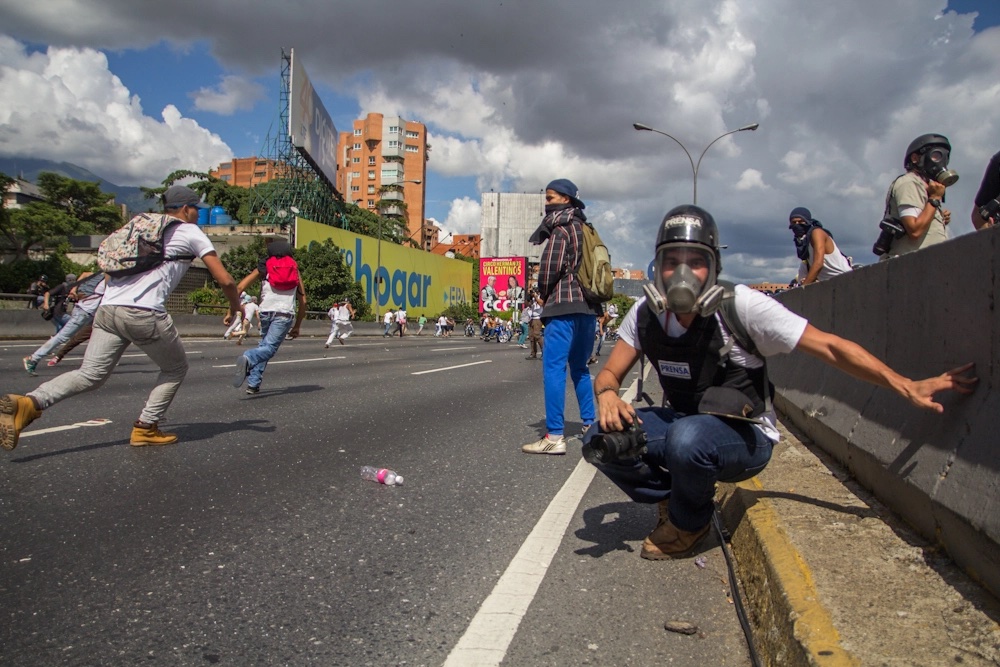
Image taken by Venezuelan photojournalist Rafael Hernández during a protest in Venezuela, April 2017. (Photo: Rafael Hernández)
“One lives in constant fear or concern when reporting on the street, not only because here in Venezuela the crime rate is very high, but also because the authorities generally do not allow you to do your job. That is why we always try to be in groups or in pairs, and assess risk factors before reporting," he explained.
In addition to the SNTP, the local non-profit organizations Redes Ayuda, IPYS Venezuela and Espacio Público are some of the organizations that remain vigilant and support journalists who face problems due to their work, according to Hernández.
"Basically, on the issues of photojournalists we have offered legal support," Carlos Correa, director of Espacio Público, told LJR. “We have documented cases of photojournalists for many years.”
In relation to lost work equipment, Espacio Público helps journalists and photojournalists prepare forms and contact international organizations that have funds to replace equipment, generally for freelancers who are not hired by any media or agency, Correa said.
In Argentina, one of the organizations that supports photojournalists is the Association of Graphic Reporters (Argra). This association of photojournalists, which currently has about a thousand active members nationwide, was created in 1942 to defend and regulate the rights of photojournalists in the country.
“As photojournalists, we know that in our work –which sometimes involves friction with the security forces – there can be aggression from a police officer disturbed by the event, and other situations in which we see the police are targeting us,” Argra president Daniel Vides told LJR. "We clearly lived this [in Argentina] in the events of 2001, since the fall of the [Fernando] de la Rúa government, when we were subjected to repression, and it happened again during the Macri years."
In 2017, during the government of then-president of Argentina, Mauricio Macri, a reform of the pension law for retirees was approved, which sparked social protests that were repressed with a strong police presence.
According to Vides, during those protests there were many injured photojournalists who received multiple impacts from rubber bullets to the body that caused irreversible damage.
Juan Pablo Barrientos, an Argentine photojournalist who previously collaborated for Revista Cítrica, was hit 21 times with rubber bullets during one of the demonstrations for the pensioners' law. “That day I was hit with 21 rubber bullets, 10 in the back and 11 in the front. And I have the photo of the police officer who is shooting at me," Barrientos told LJR.
"There were a number of injured photographers there that had never been in Buenos Aires," Barrientos said. During the Macri government, he said, the number of police officers on the streets during demonstrations was much higher.
Barrientos, who is 47 years old and began taking photos at 19, now works sharing photographic equipment with some of his colleagues. In one of the last demonstrations he covered, the police broke his photography equipment, according to the photojournalist.
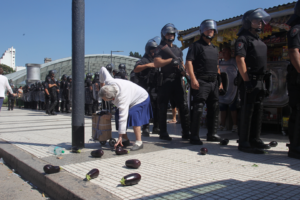
Elderly woman picking up an eggplant during "El verdurazo", a pacific protest in Buenos Aires, Argentina, February 2019. (Photo: Bernardino Ávila)
In February 2019, at a protest in Buenos Aires that became known as ‘el verdurazo’ (a play on verduras, vegetables, and cacerolazo, a type of loud protest), Barrientos and his colleague Bernardino Ávila took photos that had a significant impact on the population, Vides said.
Among those scenes, the photos showed an elderly woman picking up a vegetable from the ground, with a group of armed police behind her, and another showing police pepper-spraying a vendor carrying a crate of lettuce.
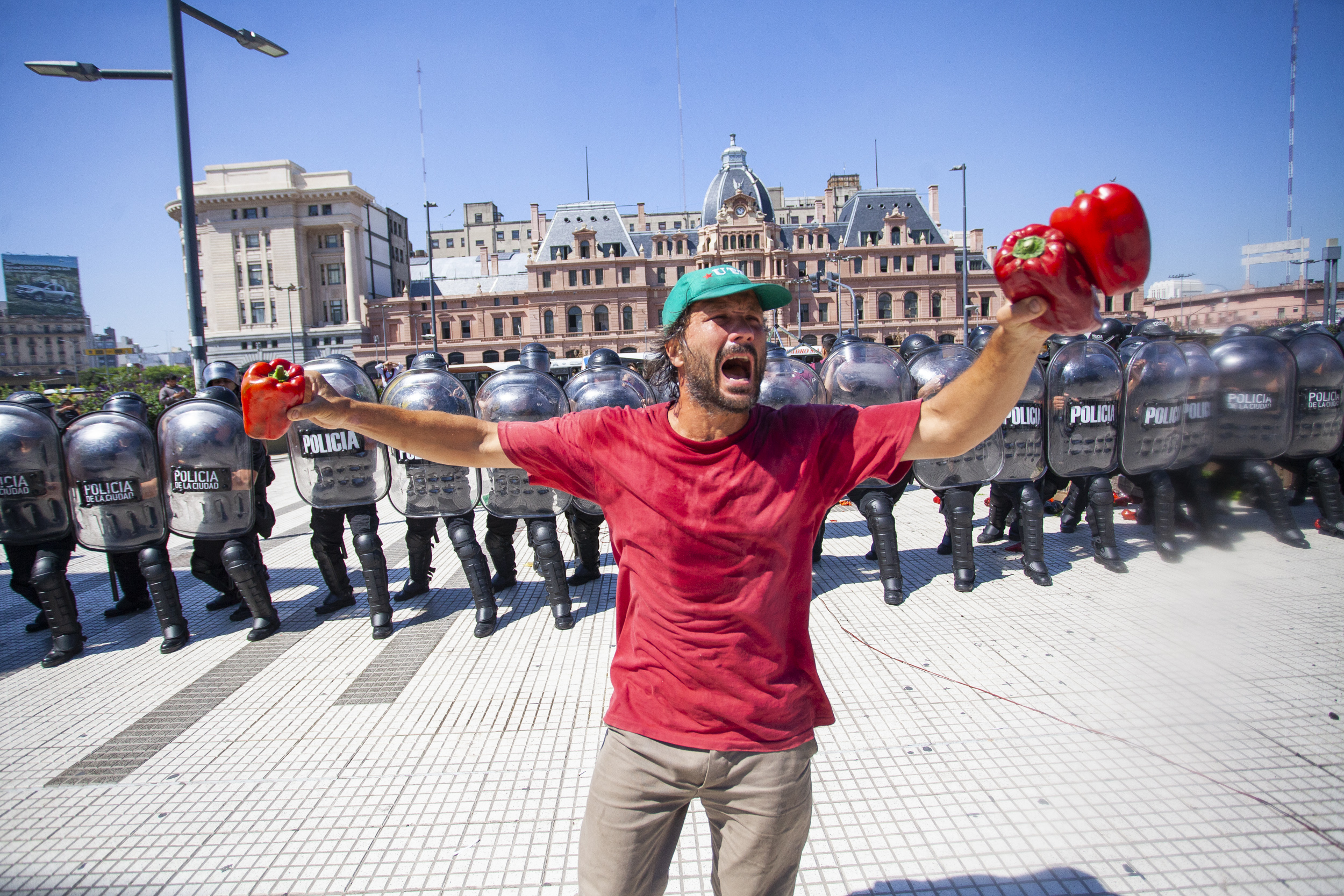
Merchant of vegetables after being sprayed with pepper gas by the police in the pacific protest known as "El verdurazo", in Buenos Aires, Argentina, February 2019. (Photo: Juan Pablo Barrientos).
‘El verdurazo’ was a peaceful protest by rural workers who began to sell their vegetables at low prices in the iconic Plaza de Mayo, in protest of the strike of farmers organizations.
A few days later, when Ávila and Barrientos were covering a small march in front of Congress, according to Barrientos, the police approached them, pointing at them, and detained them. "There were a lot of photographers, but they stopped the two of us," Barrientos said.
After being beaten and handcuffed, Barrientos and Ávila were detained for several hours, as reported by Página 12.
“As a result of my detention, they set up a case for ‘resistance to authority’ and ‘assault on the police’ which, although the charges were dropped and the case archived, it is still in the police files,” Ávila told LJR.
“Every time a law enforcement officer takes a look at my background, it raises annoying questions and clarifications that shouldn't happen. Therefore, I have to be careful not to fall into provocations or situations that lead to a clash with the police, which is common in my work,” he added.
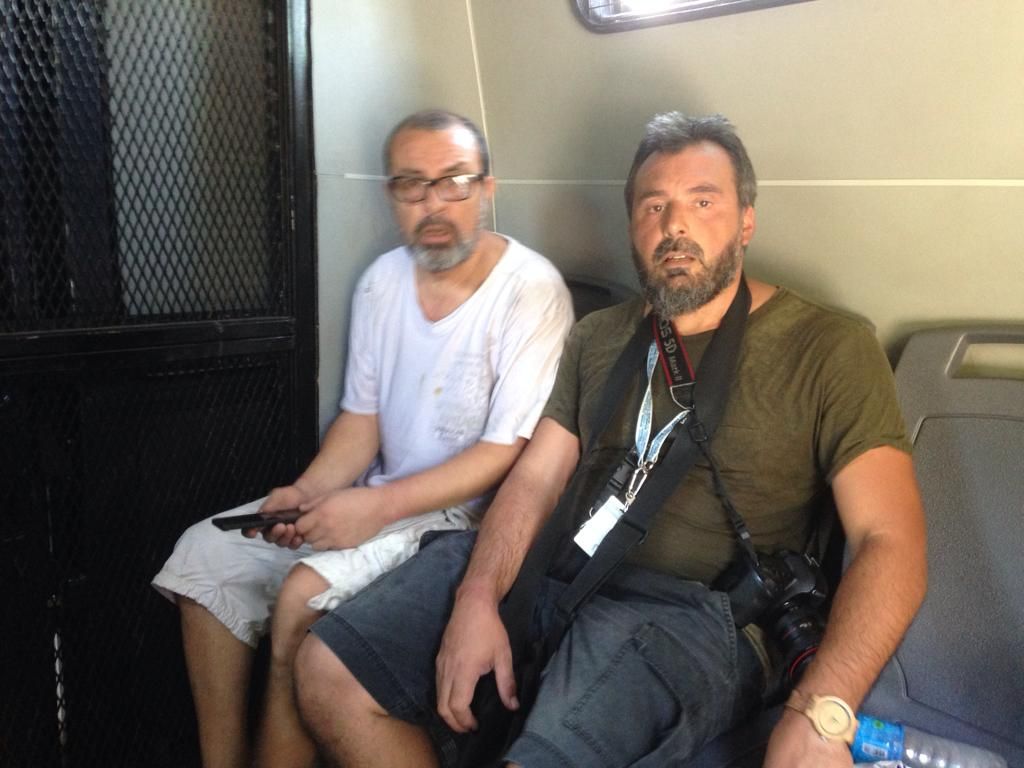
Argentinean photojournalists Bernardino Ávila y Juan Pablo Barrientos being detained by the police of the city of Buenos Aires, Argentina, February 2019. (Courtesy).
Barrientos, who was processed for the same charges as Ávila, suffered permanent damage to his equipment, he said.
“From that moment on, let's say, you reinforce your ideals. Obviously I'm doing things well, you say. If it bothers them, it is because I am doing things well, because it bothers these people that someone does a good job,” Barrientos said.
Luego de esta detención, Barrientos se cuida más por su familia, sus hijos, y por la gente que tiene alrededor, que a veces recibe amenazas en redes sociales, dijo.
Following this detention, Barrientos now takes more care of his family, his children, and the people around him, who sometimes receive threats on social media, he said.
A reform of pension plans for retirees also unleashed a wave of protests and repression in Nicaragua in April 2018.
Nicaraguan photojournalist Alfredo Zúniga, 35, covered the protests and political crisis from 2018 to 2020 as a contributor to the Associated Press. “In the most violent phases, [I did it] always with a bulletproof vest, helmet and gas mask,” Zúniga told LJR.
Still, Zúniga has been attacked multiple times during his coverage of the protests. “When the 2018 political crisis broke out, FSLN (Sandinista National Liberation Front) shock groups attacked me, hit my head with a tube and stole my equipment. They have taken me by the neck, put guns to my head, threatened to disappear me, etc.”.
To cover the current situation in Nicaragua, many journalists and photojournalists have to work under the radar, do their work quickly and be extremely careful that they are not seen or attacked by motorized paramilitaries, police officers or sympathizers of President Daniel Ortega, Zúniga explained.
Óscar Navarrete, a photojournalist for the Nicaraguan daily La Prensa since 2003, told LJR that wearing bulletproof vests and helmets during protests in his country is sometimes “insufficient” when repression levels are high.
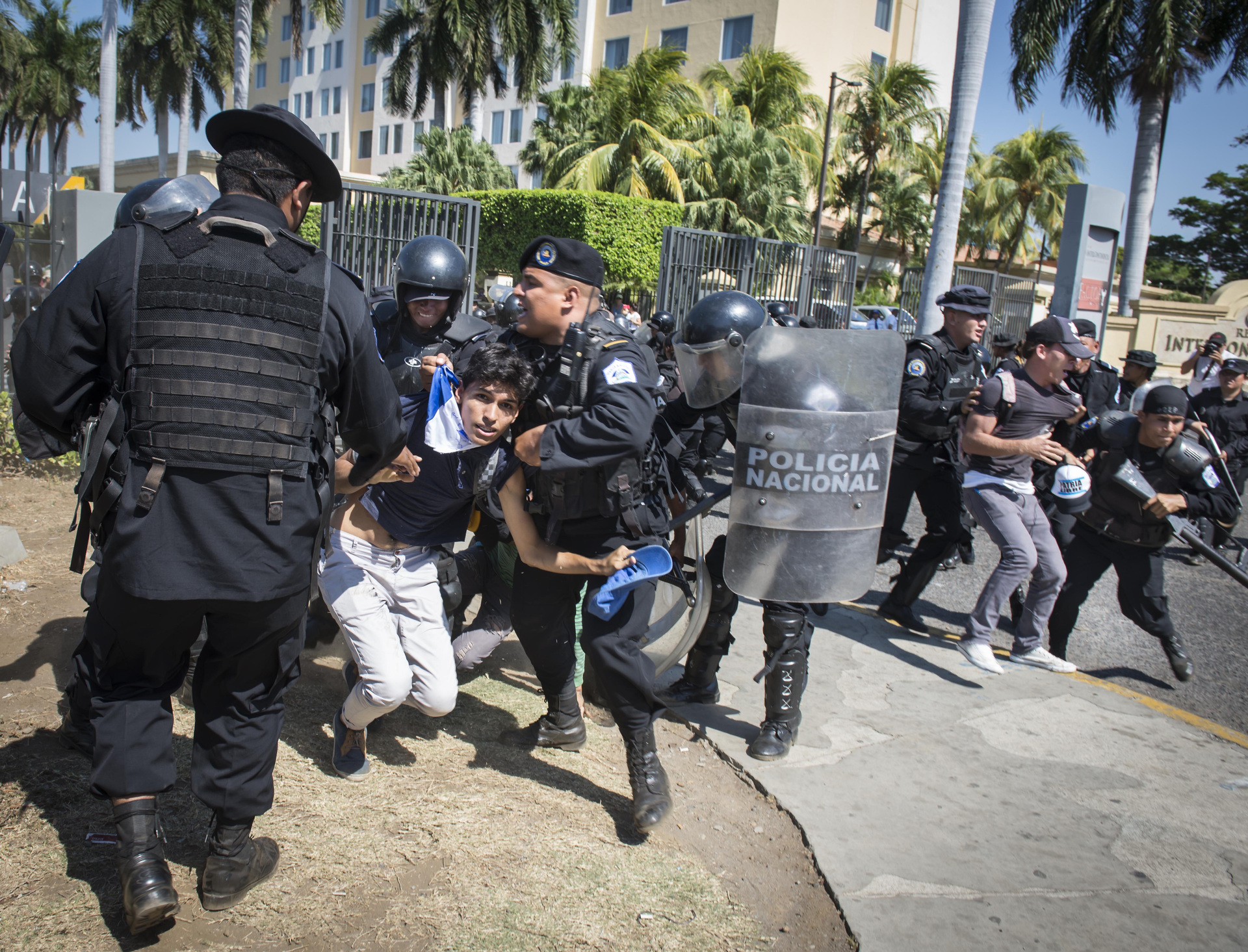
Police repression during a protest against the government in Managua, Nicaragua. (Photo: Óscar Navarrete)
Zúniga pointed out that one of the organizations that has supported them during the difficult moments of his work is Riesgo Cruzado from El Salvador, which provides protection and prevention mechanisms for journalists. Also, he added, he and many of his colleagues created the Association of Foreign Agency Correspondents in Nicaragua (ACEN).
Currently, Zúniga is a photographer for Agence France Presse (AFP) in Mozambique because working in Nicaragua became very difficult. Due to the political repression and the social and economic crisis that the country is experiencing, many of his colleagues from national media have had to go into exile due to harassment and persecution by the Ortega government, he said.
“Many colleagues have gone into exile in the midst of the pain of leaving their homes, their families and their profession, in my particular case I did not contemplate, nor have I contemplated the idea of exile, if I have to die for my profession I will, I have already received threats and I have been attacked by paramilitaries and police,” Navarrete said.
For photojournalists in Mexico, the situation is no less difficult.
In recent years, Mexico has established itself as one of the deadliest countries for journalism in the world, according to various organizations such as the Committee to Protect Journalists (CPJ).
Article 19 of Mexico is one of the organizations that helps make visible the cases of journalists and photojournalists who are attacked or threatened, issuing public alerts or creating bridges with state entities to help, according to the needs of the case. It also offers legal support and sometimes manages to raise funds to replace work equipment that has been destroyed while reporting.
"We have or have come to have support from funders, small funds, to help in emergency situations," Itzia Miravete, prevention coordinator of Article 19 Mexico, told LJR. "It depends on the capabilities of the person, it depends on the aggression, if he or she is arrested.”
For protests, specifically, Article 19 Mexico is part of the Front for Freedom of Expression and Social Protest, together with the Marabunta collective, the Prodh Center, among others, in addition to being part of the Red Rompe el Miedo (Break the Fear Network). This network is made up of journalists and freedom of expression advocates whose purpose is to help prevent press workers from being detained or attacked.
Félix Márquez, a freelance photographer and Associated Press contributor in Veracruz, Mexico, is part of Frontline Freelance México, a young organization created by freelance photojournalists to organize to promote respect for their work.
Márquez, who belongs to the organization's training committee, told LJR they have been training female photojournalists who, for the most part, have suffered attacks when covering the massive feminist marches of 2020.
Andrea Murcia, a photojournalist from Cuartoscuro, and Nayeli Cruz, a correspondent for El País in Mexico, have suffered firsthand the beatings and insults of a misogynist nature by police officers during the feminist protests, as they explained.
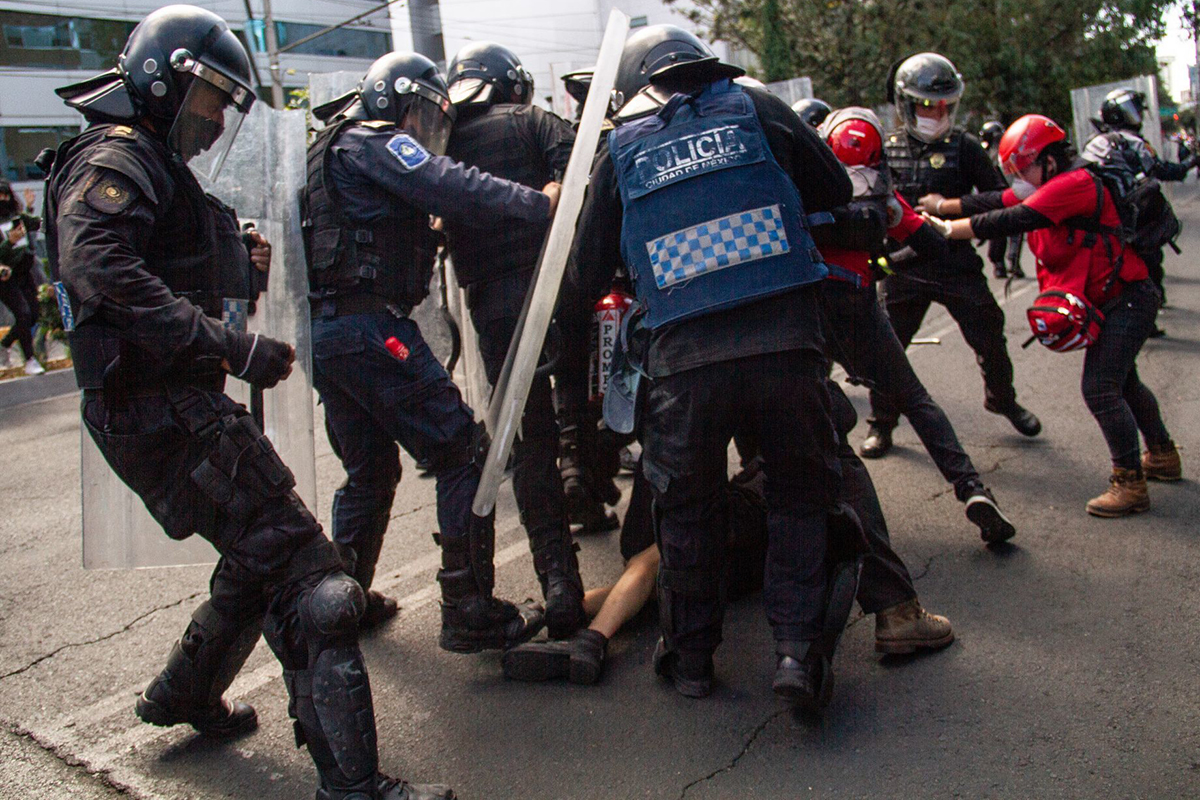
Police agents attacking a young girl during a protest in Mexico, 2020. (Photo: Andrea Murcia)
Both, at different times during the marches, have been pushed by police with their shields, and they have fallen, hitting the ground hard, they described. In the case of Murcia, as the photographer told LJR, she suffered blows to the face when the police hit her camera with their shield when she was photographing the assault of a minor. "They had to sew my lip up," Murcia said.
The photojournalist usually works in Mexico City. In the midst of it all, Murcia feels lucky that she works in the country’s capital. “I am aware that my colleagues from the states of Veracruz, Guerrero, Jalisco, really do suffer. They do suffer daily violence and precariousness at work.”
With the pandemic, Murcia said, the impact on the capital has been the decrease in salaries, in the case of many of her colleagues, in addition to having to continue going out to take photos. “We as photographers are exposed. We are not immune.”
Cruz, who does longer-term projects when not covering demonstrations, told LJR that after a protest by the feminist collective Manada Periferia at the headquarters of the Commission of Human Rights of the State of Mexico, in Ecatepec, a police officer tried to strangle one of her female colleagues with her press credential as she tried to get away from the scene in her car.
At the time, the municipality of Atizapán denied that any public security members were at the scene, as reported by El Sol de México.
“The issue of being a female photographer and being with the camera, it is inevitable, it is not like a writer who can infiltrate a little more in the marches, in some way, between people or what is happening. What happens to those of us with a camera, we are very present,” Cruz said.
* LJR tried unsuccessfully to communicate with the Police of the City of Buenos Aires in Argentina and with the Police of the City of Atizapán in Mexico.